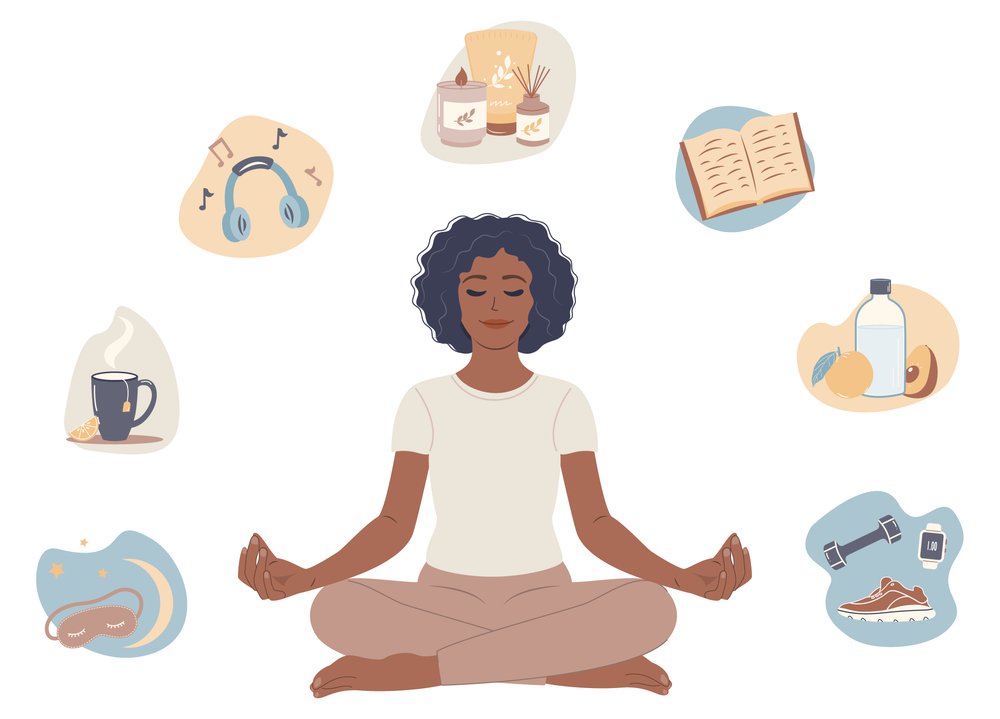Posted: May 13, 2024
Early childhood education (ECE) professionals need to take care of themselves to support and care for children. Mindfulness is a path that can help educators recognize patterns of thought or behavior that may negatively affect caring for oneself. When one feels overwhelmed or stressed, it can be difficult to focus attention. It may be challenging to support children in the learning setting. Nurturing self-care practices can be a powerful way to build resiliency, manage stress, and become a more effective educator.

Person meditating with emotional, physical, spiritual, and intellectual well-being icons around them.
Mindfulness has been defined as "paying attention, here and now, with kindness and curiosity, and then choosing my behavior" (Saltzman, 2014, pg. 2).
Dr. John Kabat-Zinn, a leader in mindful practice, has described mindfulness as "awareness that arises through paying attention, on purpose, in the present moment, non-judgmentally" (Mindful Staff, 2017, para. 2).
Using mindful practice can positively impact how an educator experiences interactions with children, families, and colleagues. Mindfulness can support improved relationships with others, including teacher-child relationships, and contribute to an educator's learning and skill development. Just like exercise, mindfulness is something that gets easier and more comfortable to do when practiced every day. Patricia Jennings, a leader in mindfulness education, notes you build mindfulness through practices that grow your "awareness muscles" (Jennings, 2015, p.18).
The core four for self-care
Four areas that contribute to self-care include emotional, physical, spiritual, and intellectual well-being. Mindfulness can enhance each of these areas to support your overall well-being.
1. Emotional health and wellness
Use mindful practice to focus attention and notice when you feel uncomfortable emotions like sadness or frustration. Pay attention to and be open to your feelings. Allow yourself to be in the moment with the feeling. Then, actively do something emotionally rewarding as you move through the uncomfortable feeling. For example, participate in activities that support positive emotions, like reading something inspirational, spending time with family or friends, and doing activities you enjoy.
2. Physical health and well-being
Focus attention on your body and energy level, how you move throughout the day, and what you eat. Savor your favorite food and pay attention to the texture and taste. Participate in physical activities like walking or other activities that support health and wellness to build resilience and manage stress.
3. Intellectual health and wellness
Approach learning with mindful curiosity. Strengthen your knowledge and thinking skills by reading, playing games, and learning new things. Focus attention on how to apply your new knowledge and how that knowledge may bring a different perspective to an area of your life.
4. Spiritual well-being
Spiritual wellness includes bringing a sense of meaning and connectedness to your life. The development of mindful practice helps an individual pay attention to and focus on the small moments and interactions throughout the day. For example, you may nurture spiritual wellness through involvement in a faith-based community. You may also nurture spiritual wellness through a connection to nature by walking, hiking, or doing other activities in a natural setting.
References:
Jennings, Patricia A. (2015). Mindfulness for Teachers: Simple Skills for Peace and Productivity in the Classroom. W.W. Norton & Co.
Mindful Staff. (2017). Jon Kabat-Zinn: Defining Mindfulness. Mindful.
Saltzman, A. (2014). A still quiet place: A mindfulness program for teaching children and adolescents to ease stress and difficult emotions. New Harbinger Publications.

